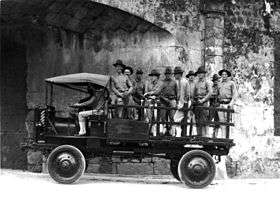Jeffery Quad
| Jefferey Quad | |
|---|---|
 U.S. Marines riding in a Jefferey Quad, Fort Santo Domingo, c. 1916 | |
| Overview | |
| Manufacturer |
Thomas B. Jeffery Company Nash Motors after 1916 |
| Production | 41,674 (1913–1928) |
| Layout | Front-engine, four-wheel-drive |
| Powertrain | |
| Engine | Buda, 4.87 litre, 4-cylinder, side-valve motor, 312 cubic inches, developing 28.9 horsepower |
| Transmission | four-speed, four wheel drive, hub-reduction gearing |
| Dimensions | |
| Curb weight | 7,900 pounds, Payload= 4,000 pounds |
The Jeffery Quad, also known as the Nash Quad or Quad is a four-wheel drive truck that was developed and built by the Thomas B. Jeffery Company from 1913 in Kenosha, Wisconsin and after 1916 by Nash Motors, which acquired the Jeffery Company. Production of the Quad continued unchanged through 1928.
The Quad introduced numerous engineering innovations. Its design and durability proved effective in traversing the muddy, rough, and unpaved roads of the times. The Quad also became one of the most successful vehicles in World War I. The Quad was produced in large numbers by Jeffery and Nash, as well as under license by other truck makers.
Development
In the years immediately preceding World War I, Jeffery designed a four-wheel-drive truck, known as the "Quad" or "Jeffery Quad", which greatly assisted the subsequent war efforts of several Allied nations, particularly the French.[1] The Jeffery Quad became the workhorse of the Allied Expeditionary Force.[2]
These unique vehicles also saw heavy service under General John J. "Blackjack" Pershing as both the Jeffery armored car and as regular transports during the Army's 1916 Punitive Expedition through Mexico; Quads were also used extensively during Pershing's later European campaigns of World War I.[3] The United States Marine Corps also adopted the Jeffery Quad, using it in the Haiti and Dominican Republic conflicts from 1915 through 1917.[4]
Approximately 11,500 Jeffery and Nash Quads were built between 1913 and 1919. "Four-wheel drive trucks had been built before ... but aside from the Jeffery Quad (Nash Quad, per subsequent purchase) earlier designs were inefficient, crude, and flimsy."[5]
Design
The Quad had four-wheel drive and four-wheel brakes, as well as an innovative four-wheel steering system.[6] This novel approach to steering allowed the rear wheels to track the front wheels around turns, such that the rear wheels didn't have to dig new "ruts" on muddy curves (most roads of the day were unpaved and often badly rutted).
This four-wheel steering mechanism was integrated with Muehl limited-slip differentials on both the front and rear axles;[7] these solid axles had very high ground clearance as well, as engine power was transmitted to the four wheels from the dual differentials through rotating half-shafts that were positioned parallel to but above the load-bearing "dead" axles.[8] This combination of innovative features constituted a revolutionary approach to four-wheel drive and allowed the Quad to traverse soft or muddy conditions with unprecedented effectiveness.
Legacy
The Quad was one of the first successful four-wheel drive vehicles ever to be made, and its production continued for 15 years with a total of 41,674 units made.[9] In 1954, Nash Motors merged with Hudson Motor Car Company to form American Motors Corporation (AMC), which acquired the vehicle operations of Kaiser Jeep.
Notes
- ↑ Shrapnell-Smith, Edmund (1915). Our Despatches from the Front: Huge Deliveries of Lorries for the French Government. Drivers for Quads. American Tire Sizes, in The Commercial Motor. Temple Press (since 2011, Road Transport Media). p. 229. Retrieved 6 December 2014.
- ↑ "Charles Thomas Jeffery". The Lusitania Resource. Retrieved 6 December 2014.
- ↑ Hyde, Charles (2009). The Thomas B. Jeffery Company, 1902-1916, in Storied Independent Automakers. Wayne State University Press. pp. 1–20. ISBN 978-0-8143-3446-1. Retrieved 6 December 2014.
- ↑ Buckner, Maj. David N. (1981). Marine Corps Historical Division, ed. A Brief History of the 10th Marines (PDF). Washington D.C.: United States Marine Corps. 19000308400. Retrieved 17 March 2015.
- ↑ Mroz, Albert (2009). American Military Vehicles of World War I: An Illustrated History of Armored Cars, Staff Cars, Motorcycles, Ambulances, Trucks, Tractors and Tanks. McFarland & Company. p. 19. ISBN 978-0-7864-3960-7.
- ↑ Eckermann, Erik (2001). World history of the automobile. Society of Automotive Engineers. ISBN 978-0-7680-0800-5.
- ↑ Sturmey, Henry (1915). The Muehl Differential, An Automatic Lock, in The Commercial Motor. Temple Press (since 2011, Road Transport Media). p. 208. Retrieved 3 December 2014.
- ↑ Shrapnell-Smith, Edmund (1915). The Jeffery Quad. Steers, Brakes and Drives on All Four Wheels -- A Self-locking Differential, in The Commercial Motor. Temple Press (since 2011, Road Transport Media). pp. 206–7. Retrieved 6 December 2014.
- ↑ Redgap, Curtis; Watson, Bill (2010). "The Jefferys Quad and Nash Quad — 4x4 Ancestor to the Willys Jeep". Allpar. Retrieved 6 December 2014.
External links
- "Jeffrey Quad Lorry". landships. Retrieved 6 December 2014.
- "Jeffrey Quad". 4wdonline. Retrieved 6 December 2014.
- Nash Quad at the Internet Movie Cars Database